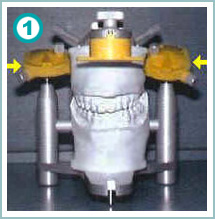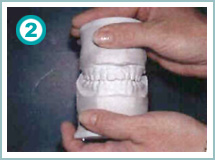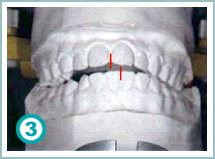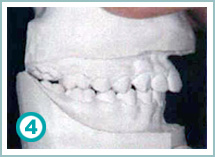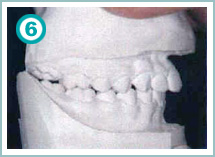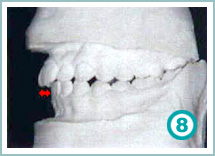
Splint Therapy
If someone is truly having a problem that is associated with their TMJ, then providing a correct bite would be a big step in the right direction. A bite such that the “molar fulcrum” is eliminated and the TM joints function within a health range. This is where splint therapy comes into the picture. A splint (when made correctly) is a physiologically correct bite. In other words, when the splint is placed over the upper teeth it instantly provides a bite where the muscles, joint and teeth do not antagonize each other, rather they work in harmony as nature intended. So, IF symptoms diminish while wearing a splint, then it can be assumed that the problem truly was TMJ in nature, a final diagnosis. Only at this point can a definitive treatment plan be developed.
Instrumentation Associated with Splint Therapy
The relationship of the jaw joint (TMJ) to the bite is the “cornerstone” of healthy physiological function. Making models of the upper and lower teeth and then holding them by hand, where most teeth mesh together, as dentists do, tells us nothing about this most important relationship. This is where articulators come into play. With a simple manipulation of the lower jaw and warmed wax, a set of models of the teeth can be related to reveal how the teeth come together when the joint is in its most physiologically functioning position.
An articulator is an instrument that functions as a bite simulator and relates models of teeth to the jaw joint.
In photo #1 are the articulated models (the arrows are pointing to the simulated jaw joint elements of the articulator). Photo #2 demonstrates very simply where the patient closes her teeth together all the time – thus in her case, forcing the jaw joint into a very harmful position.
Example of the Above Discussion
In the case shown below, the patient came in for an orthodontic evaluation. Her needs appeared uncomplicated initially. Then, when a simple manipulation of the lower jaw was performed, it became obvious that there was a more complex problem. Her jaw joints and teeth were working against each other. Upon further evaluation, it was discovered that this 13-year-old female had excessive tooth wear for her age and a history of head/jaw pain. Jaw joint imaging revealed that her left joint had suffered structural degenerative changes. All this was a result of her teeth and her jaw joints not functioning in harmony.
Splint therapy was prescribed as the most conservative diagnostic and therapeutic approach. A splint would reveal the true magnitude of the discrepancy (the diagnostic part), as well as slowing her tooth wear and relieving her discomfort (the therapeutic part).
In the photos below, the left side is shown with the models on the articulator (bite simulator) demonstrating her actual bite after splint therapy. The right photos are those of her models being held in the bite she presented the day of her initial exam.
This is her tooth occlusion when the joints are positioned in a properly functioning position. This is her teeth in the bite she first presented to my office with. This is non-functional and she is experiencing TM dysfunction symptoms.
The red lines above show how the upper and lower front teeth line up. In Photo #4, the patient is practically perfect when she closes. When her models are correctly related with the articulator (#3), the lower jaw is shifted to the left about 6 mm or 1/4 in. Notice also how her right back teeth do not line up at all. So, this young girl is experiencing significant pressure or dysfunction on her jaw joint when she closes – this is not something that is noticeable to the patient, but nonetheless is causing considerable harm.
These right-side views (#5 and 6) show the difference between the position where the joints fit and where the teeth fit. Only diagnostics utilizing articulators can uncover these discrepancies.
In these left-side photos (7 & 8), the overbite difference is significant. NOTE the first contact on the last molar - a “molar fulcrum.” Once again, the difference between the position where the joints fit and where the teeth fit are only identifiable through use of an articulator after splint therapy.
In summary, this patient wore a splint full time (24 / 7) for approximately 5 months. During this time, the splint was being adjusted at regular intervals and the jaw joints (TMJs) slowly assumed a physiologically correct functioning position. Her symptoms diminished and eventually passed completely. Now with this accomplished, it was time to determine what if any treatment is appropriate for this patient's needs. The possible treatments are described in the next section.
Treatment
Definitive treatment is performing the steps necessary to take someone from the splint they are wearing, back to their teeth touching, while VERY carefully keeping their “system” in balance by maintaining the correct relationships between joint, muscles and teeth. Since each case is different, this transition to no splint can consist of any one or combination of the following:
- Reshaping the teeth to allow a functional joint with an acceptable tooth fit. Very accurate.
- When the magnitude of correction needed exceeds reshaping, restorative dentistry may be possible. This is crowns, bridges, partials, etc., designed to facilitate healthy function. Very accurate.
- When the magnitude of correction needed exceeds restorative dentistry orthodontic treatment is considered. This is braces to move the teeth so they fit in a healthy functioning position. This is moderately accurate and may require #1 and/or #2 above to complete the treatment.
- When the magnitude of correction exceeds all three of the above outlined treatment modalities, a surgical resolution may be required. This type of surgery is not joint surgery but jaw surgery or orthognathic surgery (OGS); that is, this surgery is used to reposition the upper and lower jaw structures to allow functional stability. OGS usually requires some or all of the first three steps.
- The last option is no further treatment; that is, continue long-term splint wear to slow tooth and jaw joint degradation while maintaining an acceptable level of comfort.
* 4 and/or 5 could require the addition of 1 and/or 2 to be complete. This is due to the inherent accuracy of the different treatment modalities.
